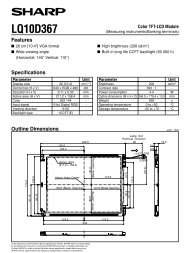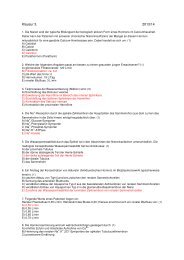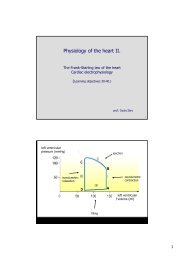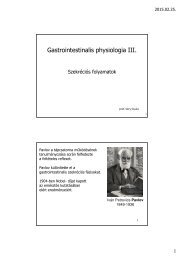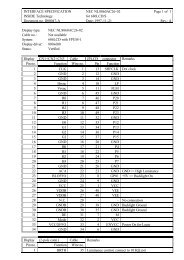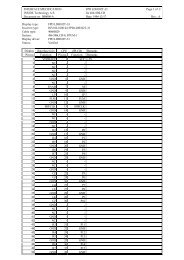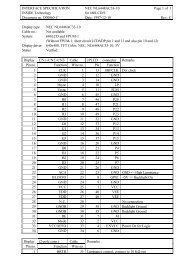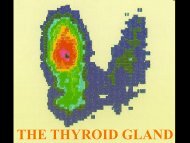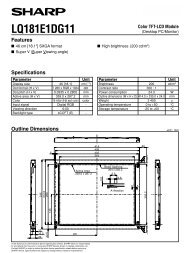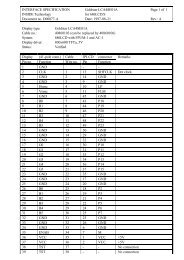Topics for the final exam in medical physiology, 2011-2012 (topics 1 ...
Topics for the final exam in medical physiology, 2011-2012 (topics 1 ...
Topics for the final exam in medical physiology, 2011-2012 (topics 1 ...
Create successful ePaper yourself
Turn your PDF publications into a flip-book with our unique Google optimized e-Paper software.
2013/2014 Medical Physiology <strong>f<strong>in</strong>al</strong> <strong>exam</strong> <strong>topics</strong>1 st semester1. Pr<strong>in</strong>ciples of control <strong>the</strong>ory.2. Passive transport mechanisms of <strong>the</strong> cell membrane.3. Active transport mechanisms of <strong>the</strong> cell membrane.4. The rest<strong>in</strong>g membrane potential.5. The electric properties of neuronal membranes.6. The axonal propagation of <strong>the</strong> action potential. Axon classification.7. Receptors, signal transduction mechanisms.8. Neurotransmission.9. The peripheral nervous system: primary sensory neurons.10. The parasympa<strong>the</strong>tic division of <strong>the</strong> autonomic nervous system.11. The sympa<strong>the</strong>tic division of <strong>the</strong> autonomic nervous system. The adrenal medulla.12. The peripheral nervous system: motor neurons, neuromuscular junction.13. Skeletal muscle: structure, electromechanical coupl<strong>in</strong>g, <strong>the</strong> biochemistry of contraction.14. Skeletal muscle: <strong>the</strong> mechanics and energetics of muscle contraction.15. Smooth muscle <strong>physiology</strong>.16. Fluid compartments of <strong>the</strong> body. The blood plasma.17. The general features of red blood cells.18. Erythropoesis.19. Hemoglob<strong>in</strong> degradation, bilirub<strong>in</strong> metabolism.20. White blood cell types. The differential leucocyte count.21. Innate immunity.22. Specific (adaptive) immunity.23. The AB0 and Rh blood groups.24. Primary hemostasis.25. Secondary hemostasis: blood clott<strong>in</strong>g (coagulation).26. Fibr<strong>in</strong>olysis. Inhibition of clott<strong>in</strong>g <strong>in</strong> vitro and <strong>in</strong> vivo.27. Respiratory mechanics 1: Static mechanics of <strong>the</strong> lung and <strong>the</strong> chest.28. Respiratory mechanics 2: Ventilation.29. Pulmonary gas exchange.30. Oxygen transport <strong>in</strong> blood.31. Carbon-dioxide transport <strong>in</strong> blood.32. The rhythmogenesis of breath<strong>in</strong>g, ventilatory reflexes elicited from <strong>the</strong> lung.33. The chemical control of ventilation.34. Biology of <strong>the</strong> airways. Metabolic and endocr<strong>in</strong>e functions of <strong>the</strong> lung.35. Hemodynamics: basic biophysical pr<strong>in</strong>ciples.36. Hemorheology.37. Cardiac muscle: structural and functional characterization, regulation of contractile <strong>for</strong>ce.38. Cardiac cycle. The jugular pulse.39. Preload and afterload, <strong>the</strong> Frank-Starl<strong>in</strong>g law of <strong>the</strong> heart.40. Cardiac muscle: cellular electro<strong>physiology</strong>.41. Electrocardiography, o<strong>the</strong>r methods <strong>for</strong> <strong>the</strong> assessment of cardiac function.42. Cardiac work and metabolism. The coronary circulation.43. Hemodynamics: The functional categorization of blood vessels.44. The function of <strong>the</strong> aorta and <strong>the</strong> arteries.45. The microcirculation: capillary solute exchange and fluid dynamics.46. The microcirculation: lymphatic circulation and edema <strong>for</strong>mation.47. The characteristics of <strong>the</strong> venous circulation.48. The regulation of local blood flow.
49. Factors determ<strong>in</strong><strong>in</strong>g cardiac output, <strong>the</strong> Guyton diagram.50. Short-term control mechanisms of arterial blood pressure.51. Long-term control of arterial blood pressure.52. Pulmonary circulation.53. Skeletal muscle blood flow, <strong>the</strong> cardiovascular adaptation to work and exercise.54. Glomerular filtration: <strong>the</strong> factors determ<strong>in</strong><strong>in</strong>g <strong>the</strong> volume and composition of filtrate55. Renal blood flow. The regulation of GFR and RBF.56. The general features of epi<strong>the</strong>lial transport mechanisms <strong>in</strong> <strong>the</strong> renal tubuli.57. Tubular reabsorption and secretion. Renal clearance.58. Renal tubular transport of organic solutes: glucose, am<strong>in</strong>o acids, ketone bodies, prote<strong>in</strong>s, uricacid, urea, UBG.59. Renal tubular transport of NaCl and water, production of <strong>the</strong> medullary osmotic gradient.60. The concentration and dilution of ur<strong>in</strong>e. Osmoregulation.61. Volume regulation (<strong>the</strong> regulation of Na + metabolism and extracellular fluid volume).62. The regulation of K + metabolism.63. The regulation of Ca 2+ and phosphate metabolism.64. The <strong>physiology</strong> of <strong>the</strong> ur<strong>in</strong>ary tract. Micturition.65. Acid-base balance.66. Pr<strong>in</strong>ciples of <strong>the</strong> regulation of <strong>the</strong> gastro<strong>in</strong>test<strong>in</strong>al tract.67. Special functional features of <strong>the</strong> gastro<strong>in</strong>test<strong>in</strong>al smooth muscle.68. The splanchnic circulation.69. Functions of <strong>the</strong> upper GI tract: chew<strong>in</strong>g, salivation, swallow<strong>in</strong>g.70. Motor functions of <strong>the</strong> stomach. Vomit<strong>in</strong>g (emesis).71. The mechanism and regulation of gastric juice secretion.72. The exocr<strong>in</strong>e pancreas: secretion and regulation.73. The bile: secretion, storage, mobilization, regulation.74. The small <strong>in</strong>test<strong>in</strong>e: digestion and absorption.75. The functions of <strong>the</strong> colon. Defecation.76. Nutrition: energy metabolism, <strong>the</strong> role of macronutrients <strong>in</strong> energy <strong>in</strong>take.77. Nutrition: water, m<strong>in</strong>erals, vitam<strong>in</strong>s, dietary fibers.78. Nutrition: The <strong>in</strong>ternal control of food <strong>in</strong>take.79. Sports <strong>physiology</strong>.2 nd semester80. Pr<strong>in</strong>ciples of endocr<strong>in</strong>e control systems.81. Characterization of <strong>the</strong> hypothalamo-hypophyseal (neuroendocr<strong>in</strong>e) system.82. Thyroid hormones: biosyn<strong>the</strong>sis, regulation, effects.83. Hormone syn<strong>the</strong>sis <strong>in</strong> <strong>the</strong> adrenal cortex. The glucocorticoids: biosyn<strong>the</strong>sis, regulation, effects.84. The endocr<strong>in</strong>e pancreas.85. The <strong>in</strong>tegrated endocr<strong>in</strong>e control of metabolism. Stress and general adaptation syndrome.86. Thermoregulation, cutaneous blood flow.87. The development and <strong>physiology</strong> of <strong>the</strong> male reproductive system88. The <strong>physiology</strong> of <strong>the</strong> female reproductive system, <strong>the</strong> menstrual cycle.89. The <strong>physiology</strong> of <strong>the</strong> sexual act, fertilization, and implantation90. The neuroendocr<strong>in</strong>e control of pregnancy, parturition and lactation.91. The fetal circulation, <strong>the</strong> cardiorespiratory adaptation of <strong>the</strong> neonate.92. Physiology of growth and puberty.93. The control of cerebral blood flow, <strong>the</strong> cerebrosp<strong>in</strong>al fluid, barrier systems of <strong>the</strong> bra<strong>in</strong>.94. The somatosensory nervous system: receptors.95. The somatosensory nervous system: <strong>the</strong> dorsal column ascend<strong>in</strong>g pathways.96. The somatosensory nervous system: <strong>the</strong> anterolateral (sp<strong>in</strong>othalamic) ascend<strong>in</strong>g pathways.
97. The somatosensory nervous system: nociception and pa<strong>in</strong>.98. The visual system: protection of <strong>the</strong> eye, image <strong>for</strong>mation, refraction errors.99. The visual system: <strong>the</strong> function of <strong>the</strong> photoreceptors, ret<strong>in</strong>al signal process<strong>in</strong>g.100. The visual system: <strong>the</strong> visual field and <strong>the</strong> visual pathways.101. The visual system : <strong>the</strong> control eye movements.102. The visual system : cerebrocortical mechanisms.103. The visual system : b<strong>in</strong>ocular vision, color vision.104. Hear<strong>in</strong>g: <strong>the</strong> function of <strong>the</strong> outer and <strong>the</strong> middle ear. Hear<strong>in</strong>g tests.105. Hear<strong>in</strong>g: <strong>the</strong> function of <strong>the</strong> <strong>in</strong>ner ear, auditory pathways.106. The <strong>physiology</strong> of olfaction.107. The <strong>physiology</strong> of taste sensation.108. The motor reflex. The structure and function of muscle proprioceptors.109. The myotatic and <strong>the</strong> <strong>in</strong>verse myotatic sp<strong>in</strong>al reflex.110. The gamma fusimotor servomechanism (gamma-loop).111. Exteroceptive sp<strong>in</strong>al reflexes.112. The sp<strong>in</strong>al <strong>in</strong>tegration of rhythmic locomotive movements. The sp<strong>in</strong>al <strong>in</strong>terneurons.113. The consequences of sp<strong>in</strong>al cord hemisection and transection.114. The control of muscle tone.115. The control of body posture. The vestibular system.116. The cerebrocortical control of movements.117. The cerebellum.118. The basal ganglia.119. The <strong>in</strong>tegration of autonomic functions <strong>in</strong> <strong>the</strong> CNS. Functions of <strong>the</strong> hypothalamus.120. The functions of <strong>the</strong> limbic system. Emotions.121. Electroencephalogram (EEG) and <strong>the</strong> <strong>physiology</strong> of sleep-wake cycles.122. The circadian rhythm and <strong>the</strong> p<strong>in</strong>eal gland.123. Cognitive functions, language and speech.124. Neuronal plasticity, learn<strong>in</strong>g and memory.



